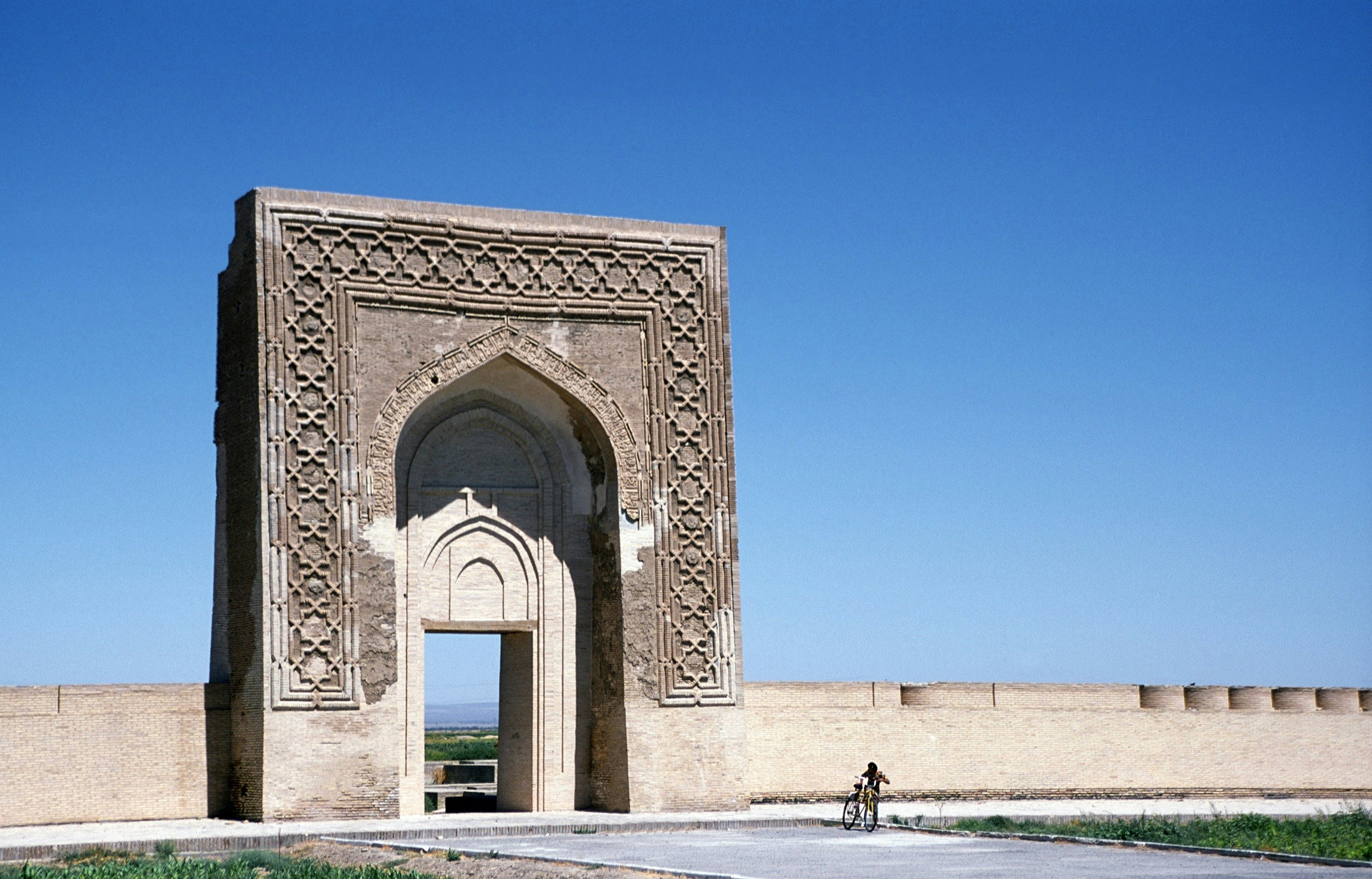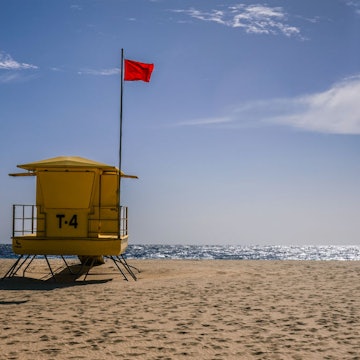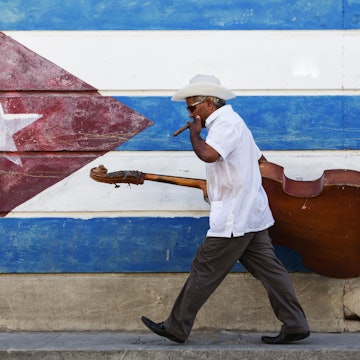
Beyond the silk road: Off the beaten track in Uzbekistan
Sponsored by

Dec 6, 2023 • 6 min read

Uzbekistan’s variety of sights and landscapes offer something for every traveler © Getty Images
Uzbekistan’s gems of Samarkand, Bukhara and Khiva never fail to impress visitors with their fabulous mosques, medressas and mausoleums. But beyond the Unesco-listed Silk Road cities and atmospheric bazaars lies a wealth of authentic, historical, and natural experiences just waiting to be explored. Take a bit of extra time to explore beyond the big sights and you'll discover mountain homestays, desert forts, ruined cities and a deeply hospitable culture hidden in some of the country's most interesting, and least-visited, corners.
Uzbekistan’s wide variety of sights and landscapes often comes as a surprise. From the baking plains of the Amu-Darya (historically known as the Oxus River) in the far south to the stony deserts of Karakalpakstan, and from the oasis towns of the Ferghana Valley to the alpine mountains just an hour outside the capital Tashkent, Uzbekistan is a diverse country just waiting to be revealed.

Journey to Bactria
Few visitors veer into Surkhandarya province in Uzbekistan's deep south but it's one of the most intriguing corners of the country, once home to thriving Buddhist monasteries, world-conquering Kushan kingdoms and Silk Road ports a thousand miles from the nearest sea.
An overnight train (a fabulous experience in itself) or short flight will drop you in Termiz, where you can make a day trip to the ancient 2000-year-old Buddhist stupa of Fayoz-Tepe and the nearby ruins of Kampyr Tepe, where Alexander the Great and his army likely crossed the Oxus River (Amu-Darya) in 329 BC, before advancing into Central Asia.
Spend an hour exploring the remains of city walls and mud-brick complexes dating back to the 4th century BC, and then finish the trip with a visit to Termiz's eye-opening archaeological museum. It's a glimpse into a long-lost Central Asian past shaped by classical Greek, Buddhist and inner Asian cultures.

Community-based homestays in Nuratau
The storied cities of Samarkand, Bukhara and Khiva may boast some of the Islamic world's most magnificent architecture but after a few days of staring at mosques, medressas and minarets you might well be itching for a different kind of experience. Refresh your travel senses by driving north from Samarkand into the remote mountains of the Nuratau-Kyzylkum Biosphere Reserve.
Here you can spend a fabulous couple of days hiking from village to village on mountain trails, past remote petroglyphs and traditional water mills, to overnight in a homestay, where you can relax on a traditional tapchan (tea bed) before learning how to bake non bread in a traditional tandyr oven. It's the classic Central Asian cultural experience and the perfect antidote to medressa overload.
Add on an overnight in a Kazakh-style yurt at nearby Aidarkul Reservoir to fully experience the stillness of the Central Asian desert.

History & Handicrafts in the Fergana Valley
The Fergana Valley is in many ways the agricultural heartland and center of craft production in Uzbekistan and it's an easy place to visit thanks to a comfortable daily train service from the capital Tashkent. The first stop is the palace of Khudayar Khan in Kokand, the power center of the 19th-century khanate, whose territory ranged from modern day Tajikistan to Kazakhstan.
A couple of hours away in Margilon is the Yodgorlik Silk Factory, where you can watch women boiling silk cocoons and spinning threads, in much the same way as their ancestors did 2000 years ago. Sunday's thunderous Kumtepa Bazaar, just outside the city, is probably the best place in the country to buy Uzbekistan's famous ikat-style silks, available in a head-spinning array of iridescent rainbow designs.

Fans of history should also head to Andijon, the hometown of Babur, the fascinating great-great-grandson of Timur (Tamerlane) who was exiled from Samarkand to Kabul in 1504, but who subsequently invaded India and established the glorious Mughul dynasty. Andijon's Babur Literary Museum displays pages from the Baburnama, Babur's magnus opus, which ranks as one of history's great historical autobiographies.
The Fergana Valley is also one of the best places to see traditional Uzbek crafts. Visit the town of Chust to pick up a typical Central Asian knife (perfect for slicing up the region's delicious melons!) or head to Rishton where several family workshops produce Central Asia's finest ceramics.

Beyond the Silk Road Cities
It's not just Uzbekistan’s cities that are steeped in Silk Road history; the traditional roads between them are also lined with a string of ancient forts, ruined cities and caravanserais. The modern highway between Samarkand and Bukhara, for example, passes right by the atmospheric gateway of the 11th-century Rabat-i-Malik Caravanserai in Karmana, built as an overnight halt on the camel caravan route.
Take the road from Bukhara southeast to Karshi and you'll drive straight through the city walls of ancient Erkurgan, a 1600-year-old Hepthalite settlement. Travel southwest instead towards Turkmenistan and you can track down the almost-forgotten ruins of Paikend, once the greatest trading city on this side of the Amu-Darya. There's a genuine thrill in knowing you are one of the few foreigners to have explored these sites in the last 1000 years.

Karakalpakstan – the ‘Stan Within a ‘Stan’
A Russian-doll style 'stan within a stan', this autonomous republic inside Uzbekistan is home to the Karakalpak (Black Hat) ethnic group and is a superb place to get off the beaten track. The big draw is the collection of more than 50 ruined forts that pepper the terrain and dunes north of Urgench.
For a memorable day, explore half a dozen of the forts, clamber up the remarkable Zoroastrian platform at Chilpak and then spend the night in a yurt camp at the dramatic cliff top fort of Ayaz Qala.
From here you can head north to the regional capital Nukus to soak up the famous Savitsky Museum, home to one of the world's premier collections of avant-garde Soviet art.

Sufi Shrines – the Soul of Uzbekistan
The best place to get a glimpse of Uzbekistan's soul is at one of the country's popular Sufi shrines; preferably on a feast day when extended families come to cook up enormous vats of plov (pilau rice).
Some of the bigger ensembles such as the Bakhauddin Naqshbandi shrine outside Bukhara rank as some of Uzbekistan's most grandiose architectural ensembles. More intimate rural pilgrimage sites include the Mausoleum of Al-Hakim al-Termezi outside Termiz, where devotees come to recite prayers, tie wish-fulfilling scraps of cloth onto sacred trees and touch the tombs of the famous 9th-century saint.
Other fascinating shrines to visit include the tomb of the prophet Daniyar (Daniel of the lion's den fame in the Old Testament) in Samarkand, Zangi-Ata in Tashkent or the cemetery of Mizdakhan outside Nukus in remote Karakalpakstan.

Mountain Escapes
If Tashkent's summer heat gets too much to bear, drive an hour northwest into the Ugam-Chatkal National Park, where a range of outdoorsy activities beckons in the foothills of the Western Tien-Shan mountains.
Hiking trails wind up to the summit of Big Chimgan peak (3309m) to offer big views over Charvak Reservoir, while rafting trips brave the white water of the Ugam and Pskem rivers. Come in winter and you can even shush down the powdery slopes of Amirsoy, Uzbekistan's premier ski resort, or splash out on some once-in-a-lifetime Central Asian heli-skiing.
But whether it’s snow or stone, city or caravanserai, Uzbekistan’s variety of sights and landscapes offer something for every traveler.
Sponsored by Uzbekistan Tourism Board
As a travel entertainment and inspirational media outlet, we sometimes incorporate brand sponsors into our efforts. This activity is clearly labeled across our platforms.
This story was crafted collaboratively between Uzbekistan Tourism Board and Lonely Planet. Both parties provided research and curated content to produce this story. We disclose when information isn’t ours.
With sponsored content, both Lonely Planet and our brand partners have specific responsibilities:
-
Brand partner
Determines the concept, provides briefing, research material, and may provide feedback.
-
Lonely Planet
We provide expertise, firsthand insights, and verify with third-party sources when needed.













